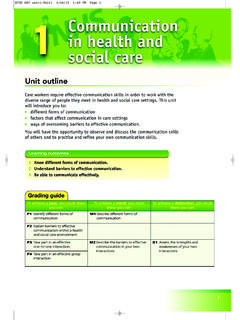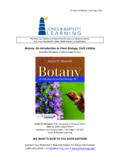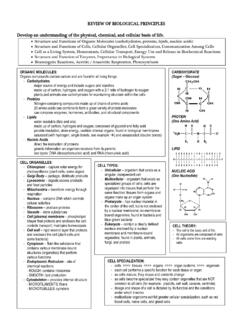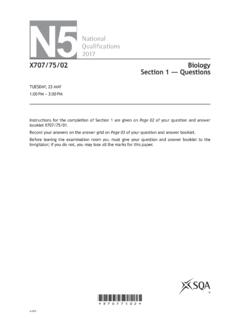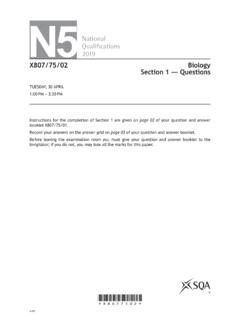Transcription of GCSE AQA Foundation Combined Science - Collins Education
1 Cell Structure Cell Structure GCSE AQA Revision Combined Science The two main types of What are the two main cell are prokaryotic and types of cell? eukaryotic. 1 1. Investigating Cells Investigating Cells GCSE AQA Revision Combined Science Magnification is the size of How is magnification the image divided by the size calculated? of the real object. 2 2. GCSE AQA Revision Combined Cell Division Cell Division Science What are chromosomes Chromosomes are made made of? of DNA. 3 3. Transport In and Transport In and Name the process GCSE AQA Revision Combined Science Out of Cells Out of Cells by which water Osmosis is the movement of molecules move across a semi- water molecules to a more permeable membrane from concentrated solution across a a dilute solution to a more semi-permeable membrane.
2 Concentrated one. 4 4. Levels of Organisation Levels of Organisation GCSE AQA Revision Combined Science An organ is a group of different What is an organ? tissues working together to perform a specific job. 5 5. GCSE AQA Revision Combined Science Digestion Digestion The three types of digestive What are the three main enzymes are protease, lipase types of digestive enzymes? and carbohydrase. 6 6. Blood and the Blood and the GCSE AQA Revision Combined Science Circulation Circulation The three types of blood What are the three different vessel are arteries, veins and types of blood vessel?
3 Capillaries. 7 7. Non-Communicable Non-Communicable GCSE AQA Revision Combined Science Coronary heart disease Diseases Diseases What two treatments can can be treated with stents be used for coronary heart to keep coronary arteries disease? open or statins to reduce cholesterol. 8 8. Transport in Plants Transport in Plants GCSE AQA Revision Combined Science Name the process by which The loss of water through water evaporates through stomata in the leaves is called stomata in the leaves. transpiration. 9 9. Pathogens and Disease Pathogens and Disease GCSE AQA Revision Combined Science A type of mosquito is the vector What is the vector of malaria?
4 Of malaria. 10 10. Human Defences Human Defences Against Disease Against Disease GCSE AQA Revision Combined Science A vaccination will make How can a person be made a person immune to the immune to a specific disease? disease. 11 11. Treating Diseases Treating Diseases GCSE AQA Revision Combined Science MRSA is a strain of bacteria What is MRSA? that is resistant to antibiotics. 12 12. photosynthesis photosynthesis GCSE AQA Revision Combined Science What two products are produced when carbon Glucose and oxygen are dioxide and water combine in produced by photosynthesis .
5 photosynthesis ? 13 13. respiration and respiration and GCSE AQA Revision Combined Science Exercise Exercise What is anaerobic respiration Anaerobic respiration in yeast in yeast cells called? cells is called fermentation. 14 14. Homeostasis and the Homeostasis and the Nervous System Nervous System GCSE AQA Revision Combined Science Receptors are cells which detect What is the difference stimuli, whereas effectors are between receptors and parts of the body ( muscles or effectors? glands) which produce responses to stimuli. 15 15. Hormones and Hormones and Homeostasis GCSE AQA Revision Combined Homeostasis Science What are the Hormones are the chemical chemical messengers messengers produced by produced by glands of glands of the endocrine the endocrine system?
6 System. 16 16. Hormones and Hormones and The four hormones that Reproduction Reproduction GCSE AQA Revision Combined Science control the menstrual cycle What four hormones are are follicle stimulating involved in the menstrual hormone (FSH), oestrogen, cycle? luteinising hormone (LH) and progesterone. 17 17. Sexual and Asexual Sexual and Asexual Reproduction Reproduction GCSE AQA Revision Combined Science What type of cell division Gametes are formed by forms gametes? meiosis. 18 18. Variation and Evolution Patterns of Inheritance Variation and Evolution Patterns of Inheritance GCSE AQA Revision Combined Science What word describes having Heterozygous means having two different alleles for a two different alleles for a gene?
7 Gene. 19 19. GCSE AQA Revision Combined Science What process is the Evolution is the gradual change gradual change in the in the inherited characteristics of inherited characteristics of a a population over time. population over time? 20 20. Selective breeding is the Manipulating Genes Manipulating Genes traditional, natural process of GCSE AQA Revision Combined Science breeding plants and animals with certain, desirable genetic How is selective breeding features. Genetic engineering different from genetic is a modern, faster way of engineering? bringing about changes in organisms.
8 It is the artificial process of transplanting genes for a desired characteristic 21 21. into an organism. GCSE AQA Revision Combined Classification Classification Science What is the classification system called in The binomial system names which organisms are given a organisms by their genus +. two-part name made up of species. their genus + species? 22 22. GCSE AQA Revision Combined Science Ecosystems Ecosystems A population is a group of What is a population? individuals of one species living in a habitat. 23 23. Cycles and Feeding Cycles and Feeding Relationships Relationships GCSE AQA Revision Combined Science What are the top consumers The top consumers in a food in a food chain called?
9 Chain are apex predators. 24 24. Disrupting Ecosystems Disrupting Ecosystems GCSE AQA Revision Combined Science Carbon dioxide and methane Name two gases that both contribute to global contribute to global warming. warming. 25 25. Atoms, Elements, Atoms, Elements, Compounds and Fractional distillation is used Compounds and GCSE AQA Revision Combined Science Mixtures to separate components Mixtures Explain how fractional with different boiling points distillation can be used to from a mixture. The mixture separate a mixture. is heated gradually and each component is collected when it boils.
10 26 26. Atoms and the Atoms and the Periodic Table Periodic Table GCSE AQA Revision Combined Science Each isotope of an element If an element has different has the same number of isotopes, what does this protons but a different mean? number of neutrons in each atom. 27 27. The Periodic Table The Periodic Table What are the GCSE AQA Revision Combined elements in these Science groups of the a) Group 0 the noble gases Periodic Table known as? b) Group 1 the alkali metals a) Group 0 c) Group 7 the halogens b) Group 1. c) Group 7. 28 28. States of Matter States of Matter GCSE AQA Revision Combined State of substance State symbol Complete the table.


